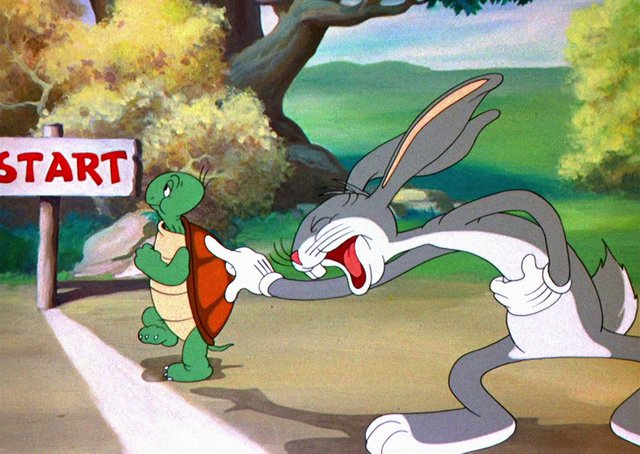OPEN SOURCE CURRICULUM SERIES: ROBOTICS FOR KIDS LESSON PLAN NUMBER #2 - THE TORTOISE AND THE HARE
Lesson Plan #2 is based on the very popular story of the tortoise and the hare. Students learn moral lessons from this story as well as showcase their creativity in creating the models.

PHOTO CREDIT: CURSO NORUEGO.ES
Objectives
The objectives of this lesson are:
- Learn the different animals that move fast and move slow.
- Teach kids how to respect all people.
- Design robotic replica to mimic the animal as close as possible.
- <<< add your objectives here >>>
Enduring Understanding
- Animals are not created equal. Some animals are big, some are small. Some move fast, and some move slow.
- Self-confidence is a good thing but overconfidence may bring some bad results.
- Reaching your goal does not require being fast. It’s how you persevere to get to the finish line.
Essential Questions
- What makes animals run faster than others?
- Why do some animals move faster than others?
- How being overconfident can result to unfavorable outcomes?
- What must someone do to be successful?
STEM Application

SCIENCE
As with the previous story, Science is an obvious field of study when it comes to animals and their characteristics. Investigation of animal behavior and characteristics is a scientific process which children should learn. Discovery is a sweet reward of this scientific process and learning how things are working and why things are working the way they are is what Science is about.
Tortoise
- Fun facts about tortoise (http://www.sciencekids.co.nz/sciencefacts/animals/turtle.html).
- Discuss the strengths of tortoise over its seemingly weak traits: being slow moving animal.
- What makes tortoise unique from other animals? Is being slow a disadvantage for the tortoise?
- In the story, why do you think the tortoise agreed to the race challenge of the hare “knowing” that the hare is significantly faster than the tortoise?
- Discuss with the students what makes a tortoise move slow. Does it also swim slow?
Hare
- Fun facts about hare (http://www.sciencekids.co.nz/sciencefacts/animals/hare.html).
- Discuss the strengths and weaknesses of a hare in general.
- Ask the students what other animals run faster than the hare.
- Discuss why the hare challenged the tortoise in a race when it knows the tortoise will never win against him.
- Reflect why the hare lost the race. What did he do wrong? Can students sometimes act like the hare? Or the tortoise?
ENGINEERING AND MATHEMATICS
Whenever possible, show the students how the tortoise could have beaten the hare in normal circumstances. If not, show them why not? Give a concrete example by showing a race track or simply establishing Point A and Point B and factoring the speed of the hare over the speed of the turtle. What possibilities are there for the tortoise to win over the hare?
In the making the robotic model, ask the students to alter the design of the tortoise to give an edge over the hare in order to win the race. Make sure the general design of the tortoise is preserved after the alteration so that the tortoise is still recognizable.
Vocabulary
Terms to Know. Have students learn the following terms, find the definitions, using them in a sentence, determining the antonym of the terms, and other ways that the students will get to use the words. Real-world application is preferred. Add more words if necessary, according to your own students' needs.
confidence, humbleness, overconfident, outcome, persistence, victorious
Values Education
The story of the tortoise and the hare shows some very important lessons for children of all ages.
- One’s weakness should not stop him to succeed.
- Perseverance is one of the keys to succeed in life especially when all around you say otherwise.
- Self-confidence is good. Overconfidence can lead to complacency and human pride.
- Everyone has his own weaknesses and strengths. Nobody's perfect.
- Respect others no matter how you perceive them to be.
hmm good thinking ...
i just upvoted you .. !!
Thank you! Cheers!
I really like what u teach very systematic and very approachable to kids....good work
Thank you, @perennial. Happy to share what I have been doing for the past 25 years... teaching ;-)
That is what i call a noble profession
As noble as it can get. It's a calling and those who are simply forced to dive into teaching find themselves frustrated and tired and bored and all sorts of negative feelings and emotions. Then it doesn't feel like a noble profession at all.
But for those who are called to teach, it's a dream come true. A mission being fulfilled.
Upvoted and resteemed.
Thanks for the support ;-)
nice post education steemiteducation opensource story kids
@cjclaro
heheheh :)
Esa tortuguita está genial, jajaja. De las preguntas, me gustó la que dice:
¿Por qué alguien debe ser exitoso?
Estas preguntas despiertan en el estudiante, ese deseo de saber más y buscar ganar siempre. Excelente post, bro
Esa es la historia de la tortuga y la liebre. ¡Buenísima! Es una buena historia acerca de la perseverancia, que llevó. a la tortuga a ganar la carrera
muy buena lección.